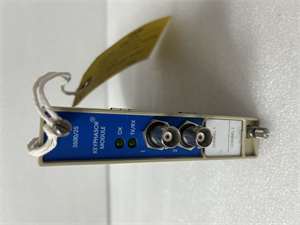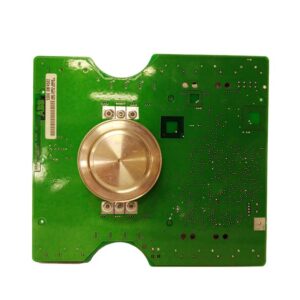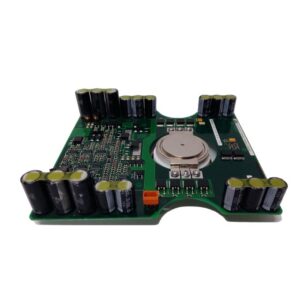Description
1. Detailed Parameter Table
| Parameter Name | Parameter Value |
| Product Model | PXI-8840 |
| Manufacturer | National Instruments (NI) |
| Product Category | Ultra-High-Performance PXI Embedded Controller |
| Processor | Intel Core i9-11900E octa-core processor, 2.5 GHz (up to 4.9 GHz with Turbo Boost) |
| Memory | 32 GB DDR4 SDRAM (up to 64 GB) |
| Storage | 1 TB M.2 NVMe SSD; optional 2 TB SSD |
| PXI Interface | PCIe Gen 4 x16 link to PXI backplane |
| Operating System | Windows 10 Enterprise LTSC, Windows 11 Enterprise, LabVIEW Real-Time |
| I/O Ports | 6 USB 3.2 ports, 2 10 Gigabit Ethernet ports, 1 serial port (RS-232), 1 HDMI 2.1 port, 1 DisplayPort 1.4 |
| Expansion Slots | 1 PCIe Mini Card slot, 1 M.2 slot (for 5G/Wi-Fi 6E modules), 1 U.2 port (for additional storage) |
| Power Consumption | 90 W typical |
| Operating Temperature Range | 0 to 55 °C |
| Storage Temperature Range | -40 to 70 °C |
| Humidity Range | 5 to 95% non-condensing (operating), 5 to 95% non-condensing (storage) |
| Physical Dimensions | 16.5 cm (height) x 10.7 cm (width) x 20.3 cm (depth) |
| Weight | 2.1 kg |
| Compliance | CE, UL, CSA, FCC Part 15 Class B |
| Software Compatibility | LabVIEW, LabWindows/CVI, Measurement Studio, NI TestStand, Visual Studio, MATLAB, Python |
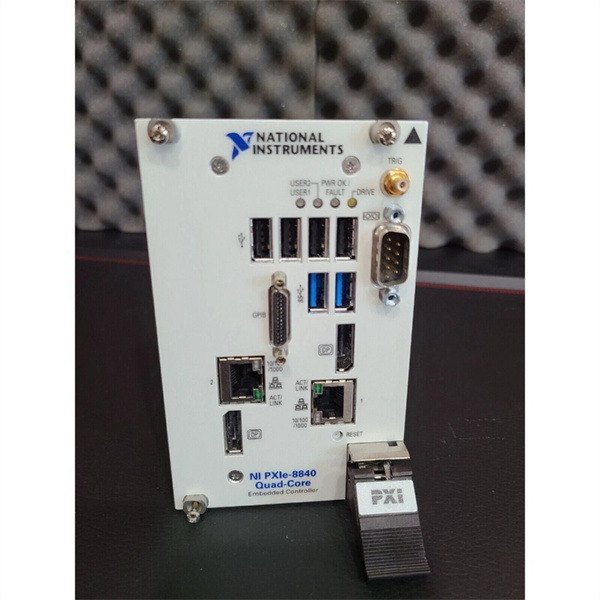
NI PXI-8840
2. Product Introduction
The NI PXI-8840 represents the pinnacle of PXI embedded controllers, engineered to meet the most demanding test, measurement, and control challenges in advanced engineering environments. As the successor to the PXI-8820, it elevates performance with cutting-edge processing architecture, next-generation connectivity, and expanded storage capabilities, making it the ideal choice for large-scale automated test systems, real-time simulation, and data-intensive applications such as 6G research and quantum computing test beds.
At its core, the PXI-8840 features an Intel Core i9-11900E octa-core processor with Turbo Boost up to 4.9 GHz, delivering a 40% performance boost over its predecessor. This processing muscle enables simultaneous execution of complex algorithms, such as machine learning-based signal classification and real-time modal analysis, without compromising throughput. The 32 GB DDR4 memory (expandable to 64 GB) ensures seamless handling of multi-channel data streams, while the 1 TB M.2 NVMe SSD—with read speeds exceeding 3,500 MB/s—facilitates ultra-fast data logging and waveform retrieval, critical for high-throughput manufacturing test floors.
The controller’s PCIe Gen 4 x16 backplane interface pushes data transfer rates to 256 GB/s, a fourfold increase over PCIe Gen 3, enabling unhindered communication with high-speed modules like 100+ GHz digitizers and multi-channel RF analyzers. This leap in bandwidth is transformative for applications requiring real-time processing of terabytes of data, such as radar cross-section measurements and high-energy physics experiments.
3. Core Advantages and Technical Highlights
Octa-Core Processing Dominance
The Intel Core i9-11900E processor’s eight cores and 16 threads redefine what’s possible in PXI systems. In automotive lidar testing, for example, the PXI-8840 can process point cloud data from 16 channels simultaneously, running object detection algorithms at 120 frames per second to validate sensor performance under dynamic conditions. This parallel processing capability also enables test engineers to run multiple independent test sequences on a single controller, maximizing system utilization in high-volume production environments.
PCIe Gen 4 Backplane Connectivity
With a PCIe Gen 4 x16 link, the PXI-8840 eliminates data bottlenecks between the controller and modules. In a 6G wireless testbed, this allows the controller to stream 160 MHz bandwidth signals from four PXIe-5669 vector signal analyzers (each operating at 50 GHz) without packet loss, enabling real-time analysis of massive MIMO (multiple-input multiple-output) systems. This high-speed connectivity also benefits emerging applications like quantum bit (qubit) control, where microsecond-level timing precision between the controller and waveform generators is critical.
Next-Gen Storage and Memory
The 1 TB M.2 NVMe SSD paired with 32 GB DDR4 memory (expandable to 64 GB) provides a storage ecosystem optimized for data-intensive workflows. In aerospace structural testing, the controller can log 1,000 channels of vibration data at 1 MS/s per channel for 24 hours—generating over 8 terabytes of data—while simultaneously running real-time fatigue analysis algorithms. The SSD’s endurance (up to 600 TBW) ensures reliable operation in continuous logging scenarios, a key advantage over traditional SATA drives.
Advanced Connectivity Options
Dual 10 Gigabit Ethernet ports, HDMI 2.1, and support for 5G/Wi-Fi 6E modules via the M.2 slot make the PXI-8840 a hub for connected test systems. In semiconductor fabs, the 10 Gigabit Ethernet links enable the controller to stream test data to cloud-based analytics platforms in real time, facilitating predictive maintenance of production equipment. The 5G module option allows remote operation of field-deployed test systems, such as those used for satellite ground station testing in remote locations.
4. Typical Application Scenarios
6G Wireless Testbeds
The PXI-8840 is the cornerstone of 6G research testbeds, controlling arrays of millimeter-wave (mmWave) transceivers (PXIe-5840) and beamforming modules. Its processing power enables real-time analysis of ultra-wideband signals (up to 1 GHz bandwidth) and machine learning-based channel modeling, while the PCIe Gen 4 link ensures that raw IQ data is transferred without latency. Researchers can validate advanced modulation schemes like FBMC (Filter Bank Multi-Carrier) and track beamforming efficiency across 128 antenna elements—tasks that would overwhelm lesser controllers.
Quantum Computing Control Systems
In quantum labs, the PXI-8840 synchronizes with PXIe-5451 arbitrary waveform generators to deliver precise control signals to qubits. Its low-latency processing ensures that qubit readout data from digitizers is analyzed in microseconds, enabling real-time error correction—critical for maintaining quantum coherence. The controller’s stability and timing precision (sub-100 ps jitter) make it suitable for controlling quantum processors with 50+ qubits, a key milestone in quantum computing development.
High-Volume Semiconductor Test
Semiconductor manufacturers leverage the PXI-8840 in test cells for advanced processors and FPGAs. It controls high-speed digital testers (PXIe-6571) operating at 12.5 Gbps per pin, while simultaneously running parametric tests via PXIe-4162 source measure units (SMUs). The controller’s parallel processing capability allows it to test four devices under test (DUTs) simultaneously, achieving throughput rates exceeding 5,000 units per hour—all while logging detailed test data for yield analysis.
Aerospace HIL Simulation
In hardware-in-the-loop (HIL) setups for next-gen aircraft, the PXI-8840 runs real-time flight dynamics models with 100 µs time steps, processing data from 200+ sensors (via PXIe-6376 DAQ modules) and generating control signals for avionics hardware. Its deterministic performance (jitter < 1 µs) ensures accurate simulation of high-speed events like engine surge, while the large SSD storage captures terabytes of flight data for post-test analysis.
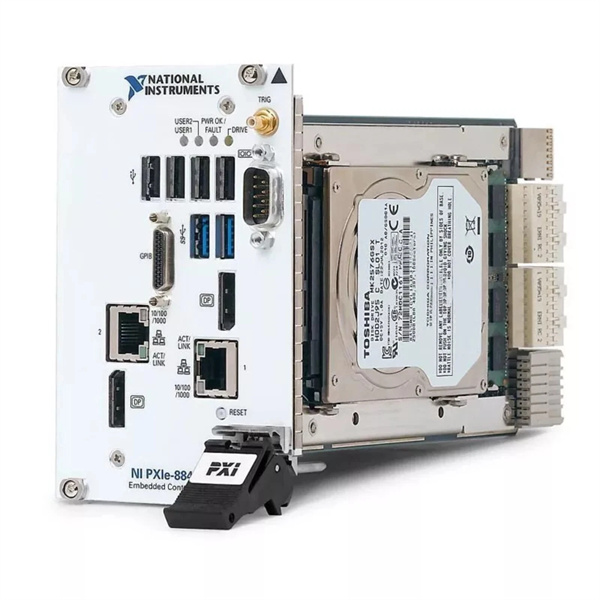
NI PXI-8840
5. Related Model Recommendations
PXIe Chassis
The PXI-8840 requires a PCIe Gen 4-compatible chassis such as the PXIE-1095 (18-slot) or PXIE-1082 (18-slot, ruggedized). These chassis feature Gen 4 backplanes to fully utilize the controller’s x16 link, supporting multi-module configurations with aggregate data rates up to 256 GB/s. The PXIE-1095 includes advanced cooling for high-power modules, making it ideal for RF and quantum test setups.
High-Speed RF Modules
Pair the controller with PXIe-5669 vector signal analyzers (up to 50 GHz) and PXIe-5679 signal generators (up to 50 GHz) for 6G and radar testing. The PXI-8840’s processing power enables real-time demodulation of 1 GHz bandwidth signals, while the Gen 4 link ensures continuous data streaming without dropped samples.
Quantum Control Modules
For quantum applications, combine with PXIe-5451 arbitrary waveform generators (1 GS/s, 16-bit) and PXIe-5172 digitizers (2 GS/s) to generate and measure qubit control signals. The controller’s low-latency processing and precise timing synchronization (via PXIe-6678T timing module) are critical for quantum error correction.
Software Tools
Leverage LabVIEW 2023 for graphical programming of real-time control loops, TestStand 2023 for high-throughput test sequence management, and DIAdem 2023 for post-processing terabytes of test data. The controller also supports Python libraries like NumPy and TensorFlow, enabling integration of machine learning models for predictive maintenance and signal classification.
6. Installation, Commissioning and Maintenance Instructions
Installation Preparation
Ensure the PXIe chassis (PXIE-1095 recommended) is powered off and grounded. Use an anti-static workstation and wristband when handling the controller. Align the PXI-8840 with the system slot guide rails, ensuring the PCIe Gen 4 connector is properly seated, then secure with front panel screws. Connect 10 Gigabit Ethernet cables to corporate and test networks, and attach peripherals via USB/HDMI ports. Verify the chassis power supply can deliver 90 W+ for the controller.
Commissioning Steps
Power on the chassis and launch NI MAX to confirm controller detection. Install NI Driver Suite 2023 Q3 or later for full Gen 4 support. Configure network settings: assign one 10 Gigabit port to test system traffic and the second to cloud/data center connectivity. Run the NI System Configuration tool to validate backplane bandwidth (should exceed 200 GB/s). For quantum/real-time applications, install LabVIEW Real-Time 2023 and configure the controller for deterministic execution (jitter < 1 µs). Test with a multi-module setup (e.g., 4x PXIe-5669) to verify sustained data throughput.
Maintenance Suggestions
Schedule monthly firmware updates via NI Update Service to maintain Gen 4 compatibility and security patches. Monitor SSD health using NI Storage Monitor—replace when wear level exceeds 90%. Clean chassis air filters weekly in dusty environments to prevent thermal throttling. Back up critical test programs and data to U.2 SSDs or cloud storage. For memory upgrades, use DDR4-3200 ECC modules to maintain data integrity in high-reliability applications.
7. Service and Guarantee Commitment
NI provides a 3-year standard warranty for the PXI-8840, with optional 5-year extensions. During warranty, NI offers 24/7 technical support via dedicated quantum/RF application engineers, ensuring rapid resolution of complex issues. Out-of-warranty repairs include priority handling and loaner units to minimize downtime. Calibration services (ISO 17025 accredited) are available annually to maintain timing and synchronization accuracy. NI also offers on-site installation services for complex setups, including quantum testbeds and 6G testbeds, with certified engineers ensuring optimal performance.

